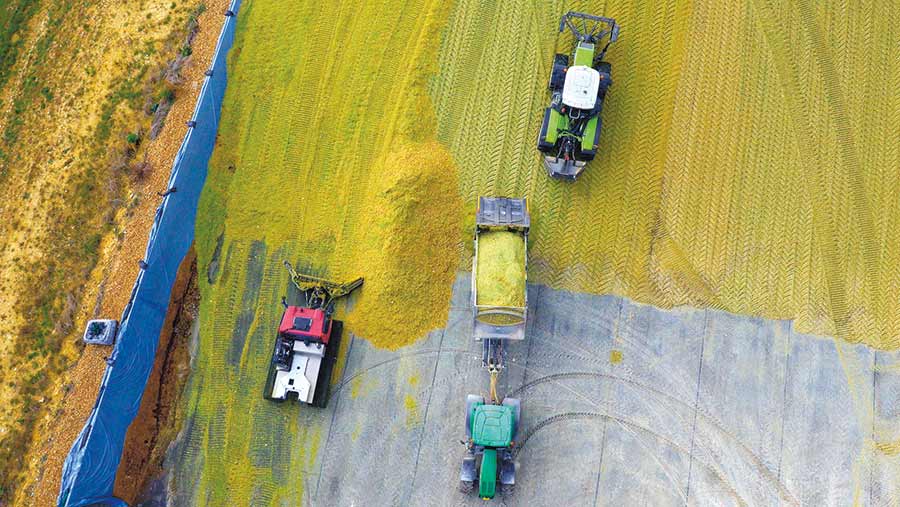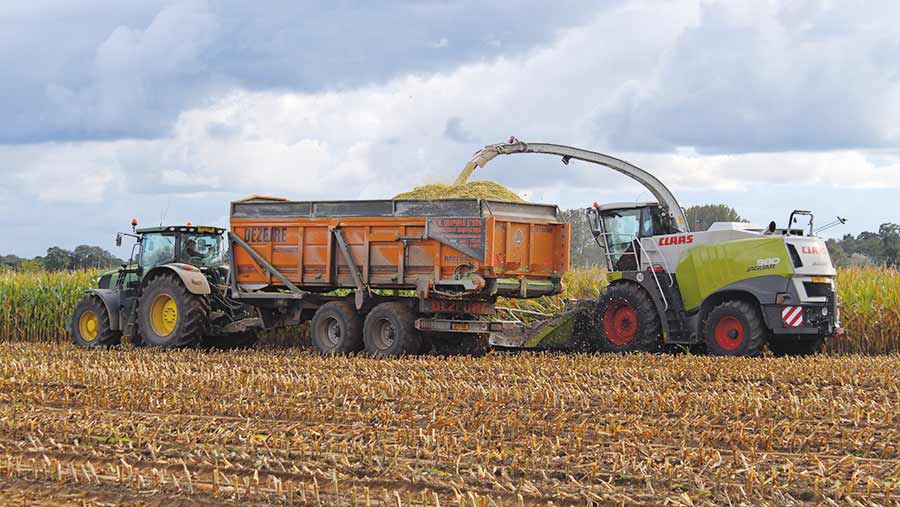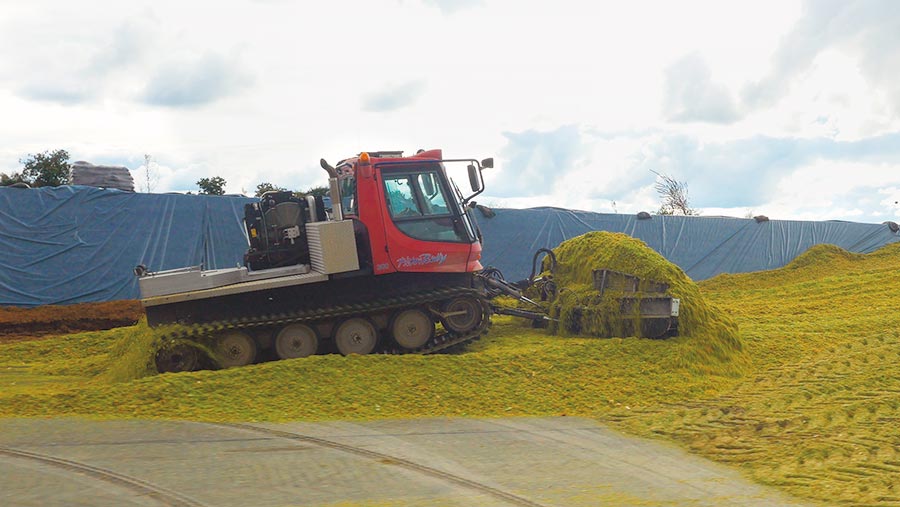Contractor on his choice of kit for 80,000t silage job
After winning a contract to chop all the feedstock for a new 4.5MW biogas plant in Swaffham, Norfolk, Will Chapman began putting together a machinery fleet that was up to the job.
Once he had settled on a brace of Jaguar 900-series foragers to handle harvesting duties, he needed to come up with a haulage and clamping set-up that could deal with their massive output.
That came in the form of a trio of Belgian-built Dezeure transfer trailers supplying artic lorries, and a 337hp Pistenbully piste basher teamed with a Claas Xerion 3800 on the clamp.
We caught up with him as he was coming to the end of his first full season with the system.
See also: Contractor tips for reducing compaction during late crop harvests
Why did you invest in transfer trailers?
We wanted to keep tractors and trailers off the road as much as possible, so we decided to use artic bulkers to haul most of the maize and wholecrop to the clamps at the AD plant.
In order to get the crop from the forager, we needed some sort of transfer trailer. We saw Dezeure’s Multitrans D20 trailers at the Lamma show and thought they looked ideal for the job.
They run off the tractor’s load-sensing hydraulics and they have remote controls so that the tractor driver can get off the tractor seat and load the lorries accurately.
It takes less than two trailer loads to fill an artic trailer – which holds roughly 26t of maize silage at about 34% dry matter – so they can keep the whole job moving smoothly.
We decided to buy three through our local dealer, G and J Peck, and they cost about £60,000 each. It was a significant investment, but the fact that we had to use the road brush only once last season shows the difference they make.
How many HGVs do you run?
We have five of our own, but we also get help from other local haulage firms.
Sometimes our lorries will be flat-out carting solid digestate out of the AD plant, so then we rely entirely on other haulage firms to shift the maize.
To try to make the most of drivers’ hours we stagger our start times and work eight-hour shifts. We also still use some tractors and trailers to plug the gaps.
Why do you run a Pistenbully on the clamp?
When we started out last year we were running a Fendt 939 and blade. It did a decent job of rolling the silage, but it couldn’t keep up with the volume of crop we had coming in and it didn’t have enough articulation to shape the clamp the way we wanted.
On top of that, we couldn’t get the sides steep enough to get the maximum amount of silage in there.
The AD plant owners, Future Biogas, had used Pistenbully machines on other sites to good effect. Together with Seb Edwards, who is the feedstock manager at our plant, we decided it was the best machine for the job.
As Future Biogas was already running other machines, it was agreed that they would buy the Pistenbully, which we would operate and maintain.
Through UK importer Off Piste Agri, Future Biogas purchased a 2001 machine, which had already clocked up 7,800 hours thundering up and down a European ski slope.
At £100,000 it was a considerable investment for a second-hand machine, but so far it has been paying off.
How has it performed?
With 337hp on tap it has considerably less horsepower than the Fendt 939 on paper, but it will push up a 26t artic lorry load of maize in less than three goes without bogging down. The Fendt would take at least four.
The six-way blade also means we can shape the clamp just the way we want. My brother, Ben, is the main driver and he aims to lay down a thin layer with each push and shape it as he goes. Because the blade moves in all directions it gives him the control to get it nice and even.
On top of that it will slope the clamp much more steeply than you would ever dare to do with a tractor, so we can fit a lot more in.
To start with we weren’t sure how well it would compact the clamp as it’s a tracked machine that is designed to tread lightly.
However, because we are only putting down thin layers and the tracks vibrate as you drive up and down, most of the air gets knocked out. At 16t, it’s also a lot heavier than it looks.
When we are in full swing we run the Pistenbully for about 14 hours a day, in which time it will burn about 320 litres of diesel. Unfortunately it has only a small fuel tank so that equates to about three fills, which gets a bit tedious.
Has it been reliable?
The Mercedes truck engine and simple nine-speed transmission seem to be bomb proof and the only significant mechanical problem was a failed hydraulic pump. We have replaced the odd track section, too, but that’s just wear and tear.
Considering it’s such a rare beast in the UK, the parts service is really impressive and generally they will be flown in from Germany to arrive the next day.
We do basic servicing ourselves, but in the winter it gets sent off to Autoplant in Woodbridge, Suffolk, for a proper overhaul.
Is it hard to drive?
It’s actually pretty straightforward to drive, but it is possible to pull the tracks off by changing direction too sharply on hard standing.
On the clamp it will happily work in seventh gear all day long and all you need to do is flick the rocker switch on the steering wheel to toggle between forward and reverse.
The blade is controlled by one joystick, which takes a while to get used to, but is actually pretty simple once mastered.
Has it been modified to work on the clamp?
It did have a few modifications. These included giving it a larger cooling pack to cope with the warmer operating conditions and a reversing fan to blow debris off the radiator.
A set of weights was added on the rear deck to help with compaction and it was fitted with narrower metal-and-rubber tracks.
The blade itself wasn’t modified, but a rubber lip was added on the bottom to stop it getting damaged on the concrete.
How does the Xerion fit in to the system?
When both foragers were in full swing the Pistenbully wasn’t quite able to keep up with the volume of silage coming in, so we needed something else to help it out.
The Xerion appealed for a number of reasons. First, it had plenty of weight for rolling the clamp effectively and it had the option of crab steer so that we could roll a larger area in each pass.
In the end we settled for a 2012 model with 1,600 hours on the clock that was one of Claas’s own demonstrator machines. We paid £89,000 for it and it has also been fairly trouble free.
After a bit of experimenting, we settled on the idea of doing the first roll with the wheels in line to push as much air out as possible. We then switched to crab steer mode for the second pass so that we cover the ground quicker.
Why didn’t you buy a loading shovel?
I know a lot of people think loading shovels are great on the clamp, but I’m not a fan.
First, I don’t think they are stable enough and there’s no chance we would work at the angles we do with the Pistenbully. Second, I don’t think they give you enough articulation for shaping the clamp – the Pistenbully’s six-way blade is far superior.
WR Chapman’s machinery fleet
Foragers: Claas Jaguar 970 and 980
Combines: Claas Lexion 780, 770, 600 and 580
Trailers: Dezeure Multitrans D20 x 3, Larrington silage trailers x 5
Clamp-building kit: Pistenbully 300 Greentech (owned by Future Biogas) and Claas Xerion 3800
Tractors: Challenger MT765C, Valtra T234 x2, Fendt 820 x 2, John Deere 6930, plus John Deere 6215R x 3 (hired)
Drill: 6m Kverneland U Drill and Kverneland Optima maize drill x 2
Cultivation kit: 3m Sumo Trio, 6m Vaderstad Carrier, seven-furrow Lemken plough, 6m Kverneland CTC
Slurry tanker: Holmer Terravariant with 21cu m Zunhammer tank and 12m dribble bar
Sprayer: 36m Farmgem self-propelled and 24m trailed Chafer
Telehandler: JCB 541-70 and 525-58
Lorries: Volvo FH12 x 2 and FM12 x 2, Scania 144G




